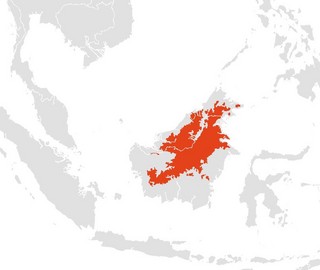Post by Ceratodromeus on Feb 14, 2017 8:31:17 GMT 5

Scientific classification
Kingdom: Animalia
Phylum: Chordata
Subphylum: Vertebrata
Class: Mammalia
Order: Carnivora
Family: Felidae
Genus: Catopuma
Species: C.badia
Geographic distribution & Habitat use
Bay cats are endemic to Borneo with two concentrations reported in the island's interior. The information suggests they occur over a wide range of habitat types, varying from swamp forests, lowland dipterocarp forest to hill forests up to at least 500 m (1,600 ft). In the mid 1990s, the most reliable sightings have been reported from the upper Kapuas River in West Kalimantan, and from the Gunung Palung National Park. One unconfirmed sighting occurred at 1,800 m (5,900 ft) on Mount Kinabalu.
They inhabit dense tropical forests, and have been observed in rocky limestone outcrops and in logged forest, and some close to the coast. At least three specimens were found near rivers, but this was probably due to collector convenience rather than evidence of habitat preference. In 2002, a bay cat was photographed in Gunung Mulu National Park in Sarawak. From 2003 to 2005, 15 bay cats were recorded in Kalimantan, Sabah, and Sarawak, but none in Brunei. These records consist of single opportunistic observations. Almost all the historical and recent records are from close proximity to water bodies such as rivers and mangroves, suggesting the bay cat may be closely associated with such habitats.
A camera trapping survey from July 2008 to January 2009 in the northwestern part of Sabah's Deramakot Forest Reserve in an area of about 112 km2 (43 sq mi) yielded one photo of a male bay cat in a total sampling effort of 1916 trap nights. This record expands the range of bay cats to the north.
Alfred Russel Wallace sent the first known skin and skull of a bay cat from Sarawak to the British Museum of Natural History in 1856. Only seven more skins surfaced in the following decades, but no living individual was caught until 1992. In that year, one was trapped on the Sarawak – Indonesian border and brought to the Sarawak Museum on the verge of death.

Biology
The bay cat is much smaller than the Asian golden cat. Its fur is of a bright chestnut colour, rather paler beneath, the limbs and the tail being rather paler and redder. The tail is elongated, tapering at the end, with a white central streak occupying the rear half of the lower side, gradually becoming wider and of a purer white towards the tip, which has a small black spot at its upper end. The ears are rounded, covered with a short blackish-brown fur at the outer side, paler brown within and with a narrow brown margin.
In the years between 1874 and 2004, only 12 specimens were measured. Their head-to-body length varied from 49.5–67 cm (19.5–26.4 in) with 30.0- to 40.3-cm-long tails. They were estimated to have an adult weight of 3–4 kg (6.6–8.8 lb), but too few living specimens have been obtained to allow a more reliable estimate.
The short, rounded head is dark greyish-brown with two dark stripes originating from the corner of each eye, and the back of the head has a dark ‘M’-shaped marking. The backs of the ears are dark greyish, lacking the central white spots found on many other cat species. The underside of the chin is white and two faint brown stripes are on the cheeks. Body proportions and the extremely long tail give it the look of the New World jaguarundi.

The secretive and nocturnal behavior of bay cats, and possibly their low population density, may be an important cause of the rarity of sightings. Camera trapping surveys during 2003–2006 yielded only one photo of a bay cat in 5,034 trap nights. According to unconfirmed anecdotal records from Sarawak, a bay cat was observed on a branch 1 m (3.3 ft) from the ground close to the river during a night hunting expedition. A local animal collector near Lachau, Sarawak, claimed he accidentally trapped two bay cats on separate occasions in December 2003. He reported the bay cats entered his aviary and attacked his pheasants. One cat died in captivity, and the other was released.
Nothing is known about their feeding ecology and reproductive behavior.
en.wikipedia.org/wiki/Bay_cat


